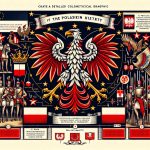
Polish ethnic identity has a rich history that goes back hundreds of years, starting with the early Slavic settlers in Central Europe. A key moment in shaping this identity was the adoption of Christianity around the end of the first millennium. This event didn’t just bring the Slavic tribes together under one religion, but it also helped form the Polish state.
Over the centuries, through changes in leadership, territorial losses, and revivals, the Polish identity has been influenced by a mix of cultural, political, and religious factors. This history shows how adaptable and resilient the Polish people are. By looking back at these events, we can better understand the deep roots of Polish identity and what it means today.
Early Slavic Settlements
Polish ethnic identity has its roots in the early Slavic settlements that began to emerge during the early medieval period. These settlements played a crucial role in shaping what we now recognize as Poland. During this time, Slavic tribes started coming together in Central Europe, setting the stage for the Polish nation’s birth. Their movement and where they settled were largely influenced by the region’s geography and weather, which in turn, shaped their culture, social structures, and language.
Before the widespread adoption of Christianity and the establishment of a formal state, these early Slavs laid the groundwork for Polish identity. They developed unique cultural practices and social structures that have left a lasting mark on Poland’s history and culture.
Let’s break this down a bit. Think of the early Slavs as the architects of modern Poland. They weren’t just people moving around aimlessly. They chose where to settle based on the land’s fertility, the availability of resources, and strategic advantages for protection against invaders. For example, the Vistula River’s basin became a central area for these settlements due to its fertile lands and navigable waters, which were perfect for trade and sustenance.
These early settlements weren’t isolated either. They interacted with their neighbors, traded goods, and sometimes even clashed. This period was dynamic, with cultures blending and evolving. The Slavs’ pagan beliefs and rituals, for instance, were integral to their identity until the arrival of Christianity, which began to reshape their societal norms and practices.
Christianization and State Formation
In 966 AD, a major shift happened for the Polish people with the Christianization of Poland under Mieszko I. This event wasn’t just about adopting a new religion; it was a game-changer for Poland’s development and its place in Europe. By embracing Christianity, Poland didn’t just change its spiritual direction; it kick-started its journey towards becoming a structured state, meshing into the wider European scene.
Let’s break it down. Before this shift, Poland was more or less a collection of territories. The introduction of Christianity under Mieszko I’s rule helped to define Poland’s borders more clearly and set up a centralized government. This was huge because it meant Poland was starting to operate like a modern country. It aligned with the Latin Church and, by extension, Western Europe, which was a big deal for its cultural and political vibe.
This change brought about big improvements in how society was organized. We’re talking about new laws, educational initiatives, and a shift in social structures. It wasn’t just about going to church on Sundays; it revolutionized Polish life from the ground up. For example, the new legal systems helped to maintain order and the educational reforms meant that more people could learn to read and write, which was a big step forward.
Moreover, becoming Christian put Poland on the map in a new way. It forged a strong bond with the Papacy, which was like getting a powerful ally. This boosted Poland’s international reputation and confirmed its status as a sovereign state.
In essence, the Christianization of Poland was not just a religious event; it was the foundation for building a modern, structured state that could hold its own on the European stage. It reshaped Poland’s identity, marking the start of a new chapter in its history, one that led to significant social, political, and cultural advancements.
Medieval Dynastic Changes
After Mieszko I founded a Christian state, Poland saw major changes in its royal families that played a big role in shaping the country. One of the biggest shifts was when Poland joined forces with Lithuania through a smart marriage, moving from the Piast family to the Jagiellonian dynasty. This move in 1385, known as the Union of Krewo, was a game-changer. It didn’t just grow Poland’s territory and power; it also helped bring Europe closer together under Christianity, making Poland a major player on the continent.
These changes in royal families were more than just political moves. They involved strategic marriages and partnerships that helped Poland not only expand its land but also mix in a rich variety of cultures. This blending of cultures added new layers to what it meant to be Polish, making the country’s identity richer and more complex. It’s a perfect example of how the choices of royal families could shape a nation’s culture and politics.
The Impact of Partitions
In the late 1700s, a series of events changed Poland forever. The country was divided not once, but three times – in 1772, 1793, and 1795. These divisions, known as the partitions of Poland, were carried out by three neighboring powers: Russia, Prussia, and Austria. They took over Polish land, essentially wiping Poland off the map. This was a huge shake-up for the people of Poland. Suddenly, they didn’t have a country to call their own.
With their state gone, Poles had to find new ways to stay connected. Language, culture, and the Roman Catholic faith became more than just parts of daily life; they turned into symbols of being Polish. These elements helped keep the spirit of Poland alive, even without a Polish state.
But this period wasn’t just about holding onto cultural identity. It was also a time of defiance. The people of Poland didn’t simply accept the loss of their country. They pushed back against the efforts of Russia, Prussia, and Austria to make them assimilate. This resistance showed the world that the Polish people weren’t going to let their identity be taken away so easily.
This shift from seeing Polish identity as tied to a state to seeing it as something broader and more cultural was significant. It showed that a nation is more than just borders on a map; it’s about shared experiences, values, and beliefs. For Poles, this meant that even without a country, they could still be a united people.
Let’s imagine for a moment what this could mean in today’s world. Think about how people use social media to connect over shared interests or backgrounds, creating communities without physical borders. Just like the Poles united around their language and faith, people today find common ground in the digital world, showing that the essence of community and identity can transcend physical boundaries.
Revival and Modern Identity
After Poland regained its independence, the Polish people started a significant effort to rebuild and modernize their ethnic identity. This was a time for reflecting on and reclaiming the Polish heritage, language, and traditions that were lost or suppressed during periods of foreign rule. Important figures in academia and culture spearheaded this movement, working to piece together a shared history that highlighted Poland’s achievements and perseverance over the years. As a result, the Polish identity that emerged was a mix of old pride and new reality, embracing European elements while keeping its distinct Slavic essence. This transformation showcased how ethnic identity can change and adapt over time, reacting to historical events and shifts in society.
Let’s break it down further. For example, language revitalization efforts were key. Polish language classes and literature were promoted to strengthen national identity. In the arts, there was a resurgence of traditional music and dance, updated with contemporary twists to appeal to younger generations. Historians and educators placed a strong emphasis on teaching Poland’s history from a Polish perspective, highlighting the nation’s role and contributions to European history.
This journey of identity renewal in Poland teaches us that maintaining a sense of self doesn’t mean rejecting change. Instead, it’s about embracing the past while navigating the present. It’s a lesson in how cultures can preserve their uniqueness while still being part of a broader, global community. It’s a testament to the resilience and adaptability of cultural identity, making it a vivid example for others facing similar challenges.
Conclusion
The story of how Polish ethnic identity came to be is quite a journey. It’s woven through a series of events and changes that stretch back centuries. Picture this: we start way back with early Slavic people setting up shop, then move through a big moment when Poland embraces Christianity. Fast forward a bit, and we see Poland growing into its own as a state, navigating through family drama with different rulers, and undergoing massive shifts due to the country being split up not once, but multiple times.
Each of these moments had its own role in shaping what it means to be Polish. It’s like a long, winding road with plenty of bumps and turns. Despite everything thrown its way – from outside forces trying to press down on it to the twists and turns within – Polish identity didn’t just survive; it thrived. It’s a testament to how identities can evolve and adapt, no matter what’s happening around them.
In simple terms, it’s the story of not giving up, keeping that sense of self strong, and always moving forward.






Comments are closed.